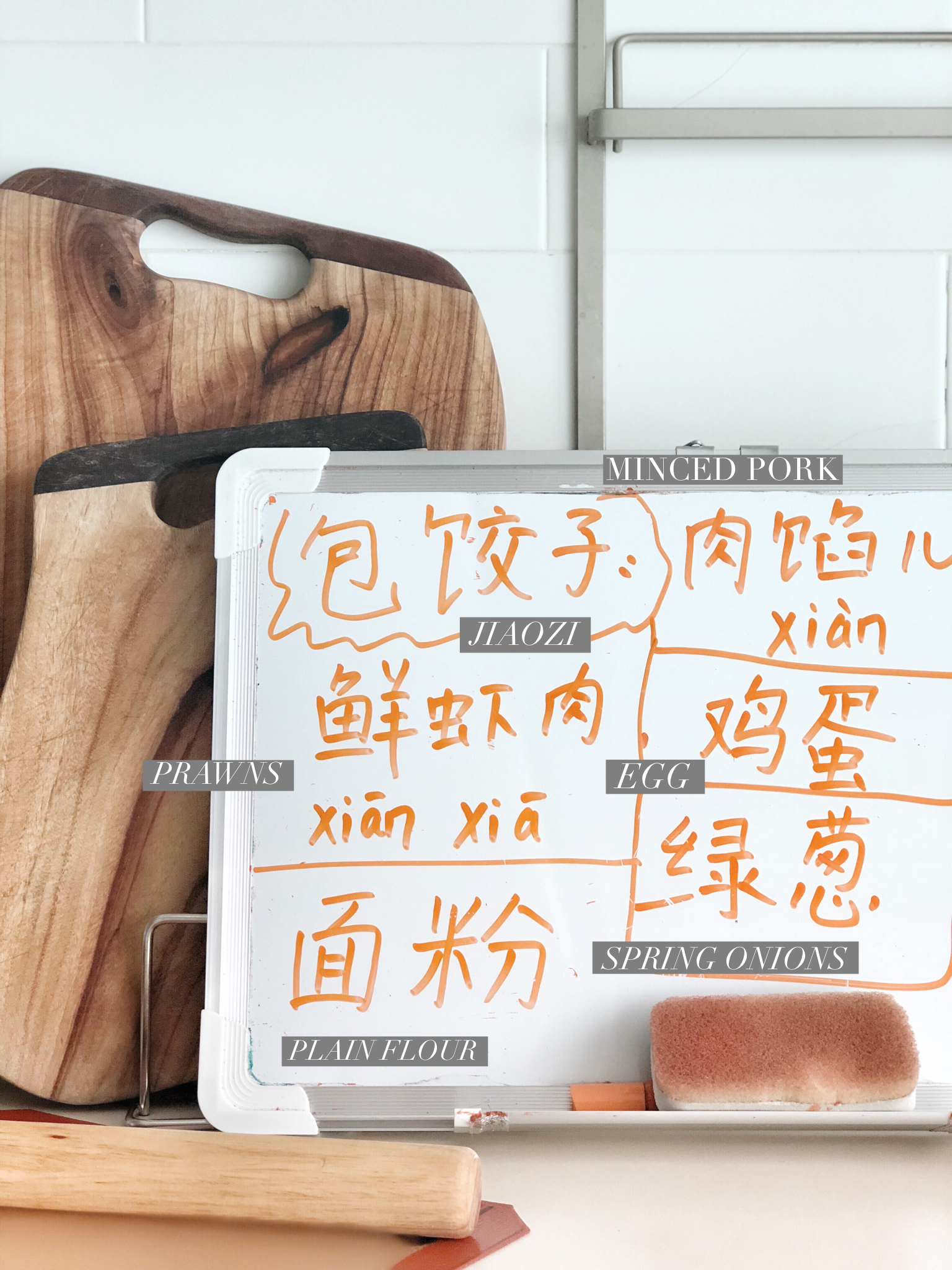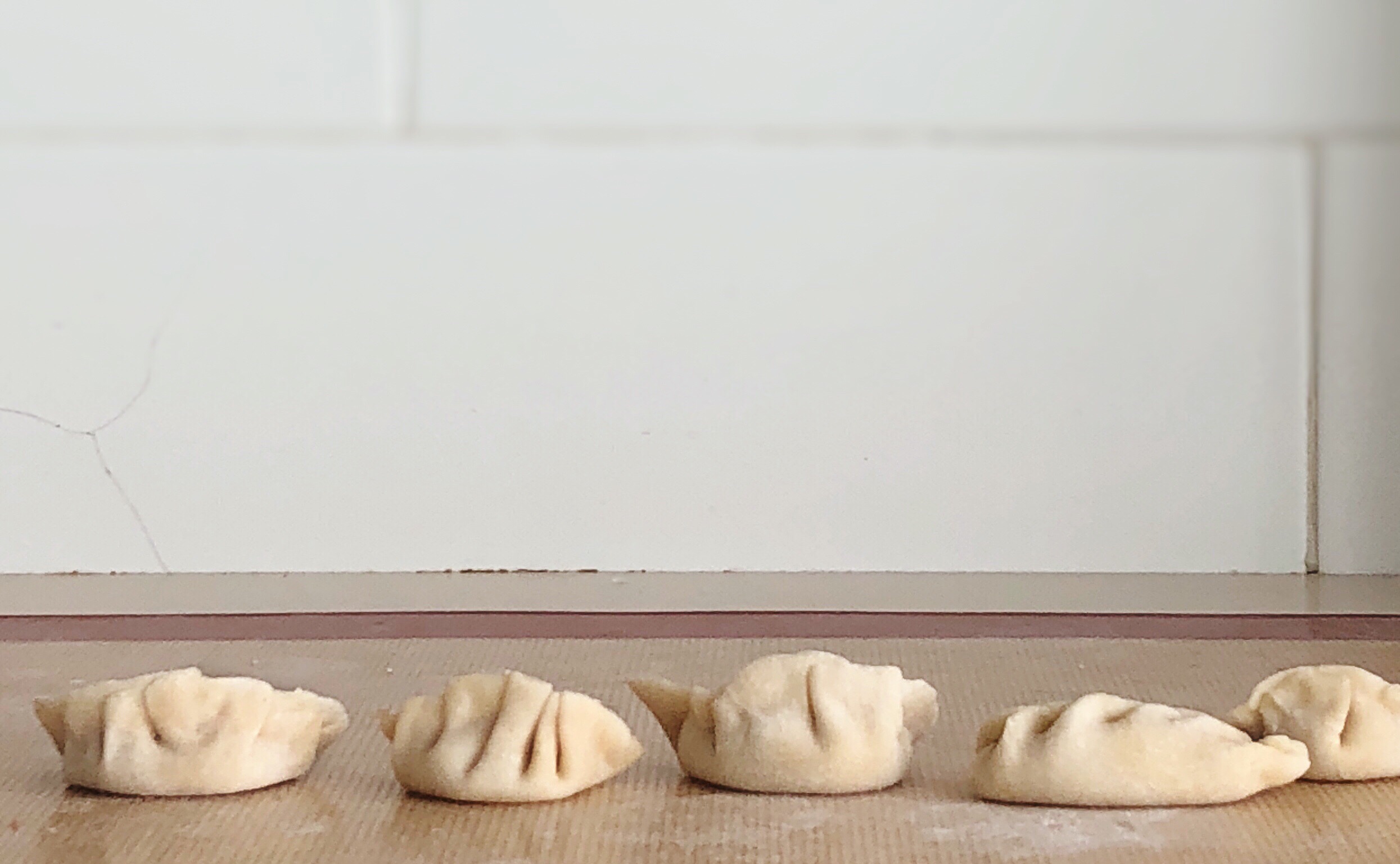
Family Food: Jiaozi 饺子

For the longest time, I’ve been trying to develop a simple jiaozi filling that is juicy and flavourful. One that wouldn’t need much additional dressing up or saucing to be tasty. This is because my daughter loves eating jiaozi, but generally prefers having them boiled and served unadorned. She also objects to having Chinese chives (she claims they taste “spicy”) and vegetables in them. After much tinkering (and feedback from my finicky daughter), I’ve developed this fairly minimalist jiaozi recipe below.
The most important building blocks for tasty, simple jiaozi
When I make dumplings for dinner parties, I tend to go into umami overdrive. I add guanciale, shio koji kombu, and a healthy punch of Red Boat salt and Kampot pepper. In addition, I steep dried porcini in the gelled chicken and jamon iberico bone stock. Dinner party dunplings pack a punch and hold up well when paired with wine. However, for my children, I’ve come to realise that I need to reach for subtlety without compromising on flavour. So, I’ve gone back to the fundamentals of a classic jiaozi and paid careful attention to how I can introduce flavour without falling into the trap of over bedazzling it.
First, I select the pork for my jiaozi filling carefully. Ideally, I get it from the wet market or from a butcher. In a pinch, I grind my jiaozi filling myself. There needs to be a nice proportion of fat in it for a flavourful and moist jiaozi. I like using pork belly, pork collar/neck and pork shoulder. Personally, I find Canadian pork or Berkshire pork most flavourful among the options most readily available in Singapore. However, I suspect that the cut of pork makes the most significant difference.

Second, I invest in preparing the tastiest gelled chicken stock I can to add flavour and moisture to my jiaozi. When I have the time, I prepare a chicken stock on the stove first. Then I add it to a whole chicken and steam it to extract a chicken essence with enough collagen to cause it to form a gel (when I’m time-strapped, I just add water to the chicken and steam it). This should yield additional umami, as well as a slightly velvety juiciness in the jiaozi filling. To me, this is the lynchpin that holds the jiaozi together. Apart from this, the recipe is pretty low key. If you like, it’s a great place to sneak in pureed or finely minced vegetables.
I like keeping a stash of jiaozi in our freezer because they’re super easy to prepare once you’ve made them. They make for a reasonably healthy frozen dinner when combined with somen, inaniwa udon, or shrimp roe noodles. I also enjoy having them tossed in the lighter, new-age chicken essences now available. If you prefer a little heat in your dressing try combining chilli oil (or XO sauce), soy or Japanese fish sauce, castor sugar, pork lard, sesame oil, freshly crushed peppercorn; tip in the freshly boiled dumplings; them ladle in some hot chicken stock and toss. Garnish with fresh herbs. I like using spring onions

Jiaozi-making as a language-learning activity for kids
This past weekend (the last one prior to the lunar new year), I turned jiaozi prep into a Chinese language activity for my kids. Sort of an elevated play dough session where you make something that you can actually eat. In the week leading up to our session, we drew up an ingredients list in Chinese and discussed the cultural significance of making and eating jiaozi at this time of year. I prepared the filling the night before, and wrapped about two-thirds of the filling in store-bought wrappers. This gave us a store of dumplings that we could tap into at the end of our session if we weren’t entirely successful at making edible jiaozi with the children.
In the morning, we made the dough for the jiaozi wraps with the kids (Viv shares her recipe for homemade wraps here). The only rule was that we needed to communicate exclusively in Mandarin. I’ll be honest. It wasn’t easy. It wasn’t orderly. There was plenty of bickering (albeit in Mandarin). But it was fun.
The kids tried their hand at rolling the dough into logs before cutting them into even portions. They flattened them with their palm and attempted to roll them into circles. And they tried their hand at wrapping their own jiaozi. There were accidents–mostly due to over-generous helpings of jiaozi filling. And homemade dough is generally more pliable, so it doesn’t cooperate as readily as store bought wrappers do. But it is also much easier to seal than the ready-made variety. So, homemade dough is much easier to achieve anything-goes jiaozi with.

How to wrap jiaozi
Everyone has their own approach to wrapping jiaozi. This is how I generally wrap mine. Keep a small bowl of water handy (although this isn’t necessary if you’re making your own jiaozi wrappers). The frozen wrappers should be defrosted in the fridge and kept under a damp towel as you work. Place approximately a No.100 ice cream scoop of filling slightly below the centre of the wrapper. Dip a clean finger into the bowl of water and use it to moisten the rim of the wrapper. Fold it over so that you end up with a semicircle, crimping only the layer facing you as you press it down to seal (watch video below). Six pleats are usually just about right. Place the completed dumplings on a tray dusted with flour. Repeat with remaining filling and wrappers.
I usually place the entire tray in the freezer. Once the jiaozi are frozen, I then transfer them into large resealable freezer bags or, if you prefer, airtight boxes. To cook, I place the frozen jiaozi directly in boiling salted water. Once they float to the surface, they should be done.
Jiaozi 饺子
Makes approximately 75 jiaozi using a No.100 ice cream scoop
Filling
380g minced pork (the fattiest you can muster. I aim for Berkshire pork belly. If you are purchasing your pork at the wet market, let the butcher know that you’re using it for wontons.)
80g minced prawn
60g piece of fresh old ginger, unpeeled
100ml iced/cold water
1 egg, beaten
1 tablespoon Kansom abalone sauce, or adjust to taste (optional)
2 tablespoons Shaoxing wine
2 teaspoons white sesame oil (I use Chee Seng)
3/4 teaspoon Red Boat or sea salt, adjust to taste
6 turns Kampot black peppercorns (or white peppercorns if you prefer), freshly crushed
100g gelled chicken stock
Gelled chicken stock
1 whole chicken (I often use a chicken I’ve purchased fresh but stored in the freezer because I never know when I’ll have the time to prepare this)
1 cup homemade chicken stock (this could be made using chicken wings with your favourite combination of aromatics. For a delicate base, I use leek, sweet turnip, water chestnuts, onion, bay leaves, and daikon). If pressed for time, use water instead.
kosher salt
Directions
To make gelled chicken stock, clean chicken and cut into 6-8 pieces. Rub generously with kosher salt.
Place in a lidded double boiler and add 1 cup chicken stock or water. (Alternatively, you could put it in a bowl and cover it with a plate.) Steam for 45 minutes. I use a steam oven set at 100 degrees Celsius.
Remove, strain liquid and cool before refrigerating. The stock should become gelatinous. I find it useful to divide the stock into 100g portions before refrigerating or freezing.
To prepare jiaozi filling, crush the ginger with a granite pestle and soak for 5 minutes in 100ml of iced/cold water.
In a mixing bowl, combine the minced pork, minced prawns, ginger-water (discard the ginger pieces), egg, abalone sauce (if using), wine, sesame oil, salt and pepper. Mix well, Use a flat bamboo dimsum spatula to stir briskly in one direction. Add the cold stock in several stages while mixing, making sure the gel/liquid is absorbed fully before continuing.
Cover tightly and refrigerate until you are ready to wrap your jiaozi.
N.B. Dumpling Skins
I usually purchase frozen Japanese gyoza skins (approximately 3 packets). However, homemade skins made with all-purpose flour and water give a completely different (and far more authentic Northern Chinese) dimension to these dumplings. I haven’t developed my own recipe. But you can find Vivian’s over here.
About Su-Lyn Tan
Su-Lyn is Aun's better half and for many years, the secret Editor behind this blog known to readers simply as S. Su-Lyn is an obsessive cook and critical eater whose two favourite pastimes are spending time with her three kids and spending time in the kitchen. She looks forward to combining the two in the years to come.

Hi Su-lyn, have you tried making them with beef & prawn, in place of pork? My husband doesn’t fancy pork, so I’m wondering what would be a good substitute. Thank you for your advice. 🙂
Hi Su-lyn,
Is it possible to replace pork with beef in this recipe? My husband doesn’t fancy pork, so I’m thinking of other substitutes. Thank you for your advice 🙂
Hi Manny, try a beef mince that has a good combination of fat and meat? I haven’t tried it myself, but there are Chinese dumplings that contain beef. I imagine it’s possible 🙂 you might need to tweak seasonings to suit the beef.